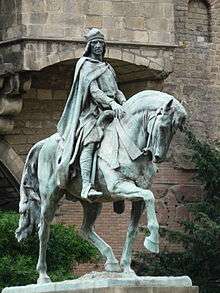Ramon Berenguer III, Count of Barcelona
| Ramon Berenguer III | |
|---|---|
|
Statue of Ramon Berenguer III by Josep Llimona | |
| Count of Barcelona | |
| Reign | 1086–1131 |
| Predecessor | Berenguer Ramon II |
| Successor | Ramon Berenguer IV |
| Spouse(s) |
María Rodríguez de Vivar Almodis Douce of Provence |
|
Issue
María Jimena or Eixemena Almodis Berenguela or Berengaria Ramon Berenguer IV, Count of Barcelona Berenguer Ramon I, Count of Provence | |
| Noble family | Barcelona |
| Father | Ramon Berenguer II |
| Mother | Matilda of Apulia |
| Born |
11 November 1082 Rodez, Viscounty of Rodez |
| Died |
23 January/19 July 1131 Barcelona |
| Buried | Santa Maria de Ripoll |
| Signature |
|
| Religion | Roman Catholic |
Ramon Berenguer III the Great was the count of Barcelona, Girona, and Ausona from 1086 (jointly with Berenguer Ramon II and solely from 1097), Besalú from 1111, Cerdanya from 1117, and count of Provence in the Holy Roman Empire, from 1112, all until his death in Barcelona in 1131. As Ramon Berenguer I, he was Count of Provence from 1112 in right of his wife.
Biography
Born on 11 November 1082 in Rodez, Viscounty of Rodez, County of Toulouse, Francia, he was the son of Ramon Berenguer II. He succeeded his father to co-rule with his uncle Berenguer Ramon II. He became the sole ruler in 1097, when Berenguer Ramon II was forced into exile.
During his rule Catalan interests were extended on both sides of the Pyrenees. By marriage or vassalage he incorporated into his realm almost all of the Catalan counties (except Urgell and Peralada). He inherited the counties of Besalú (1111) and Cerdanya (1117) and in between married Douce, heiress of Provence (1112). His dominions then stretched as far east as Nice.
In alliance with the Count of Urgell, Ramon Berenguer conquered Barbastro and Balaguer. He also established relations with the Italian maritime republics of Pisa and Genoa, and in 1114 and 1115 attacked with Pisa the then-Muslim islands of Majorca and Ibiza.[1] They became his tributaries and many Christian slaves there were recovered and set free. Ramon Berenguer also raided mainland Muslim dependencies with Pisa's help, such as Valencia, Lleida and Tortosa. In 1116, Ramon traveled to Rome to petition Pope Paschal II for a crusade to liberate Tarragona.[2] By 1118 he had captured and rebuilt Tarragona, which became the metropolitan seat of the church in Catalonia (before that, Catalans had depended ecclesiastically on the archbishopric of Narbonne).
In 1127, Ramon Berenguer signed a commercial treaty with the Genoese.[3] Toward the end of his life he became a Templar.[4] He gave his five Catalonian counties to his eldest son Ramon Berenguer IV and Provence to the younger son Berenguer Ramon.
He died on 23 January/19 July 1131 and was buried in the Santa Maria de Ripoll monastery.
Marriages and descendants
- Ramon's first wife was María Rodríguez de Vivar, second daughter of El Cid (died ca. 1105). They had one child.
- María, married Bernat III, Count of Besalú (died 1111)
- His second wife Almonds produced no children.
- His third wife was Douce (Dolça de Gévaudaun), heiress of Provence (died ca. 1127). Their union produced at least seven children:
- Ramon Berenguer IV, Count of Barcelona (1113/1114–1162) married Petronilla of Aragon, daughter of Ramiro II, King of Aragon
- Berenguer Ramon I, Count of Provence (ca. 1115–1144)
- Bernat, died young
- Berenguela or Berengaria (1116–1149), married Alfonso VII of Castile
- Jimena (1117-1136), also known as Eixemena, married Roger III, Count of Foix
- Estefania (b. 1118), married Centule II, Count of Bigorre
- Almodis, married Ponce de Cervera, mother of Agalbursa, who married Barisone II of Arborea.
References
- ↑ Bernard F. Reilly, The Contest Christian and Muslim Spain:1031-1157, (Blackwell Publishing, 1995), 176.
- ↑ Bernard F. Reilly, The Contest Christian and Muslim Spain:1031-1157, 177.
- ↑ Phillips, Jonathan P. (2007). The Second Crusade: Extending the Frontiers of Christendom. Yale University Press. p. 254. ISBN 978-0300112740.
- ↑ Helen Nicholson, A Brief History of the Knights Templar, (Constable & Robinson Ltd., 2010), 102.
| Preceded by Berenguer Ramon II |
Count of Osona 1086–1107 with Berenguer Ramon II (1082–1097) |
Succeeded by Jimena |
| Count of Barcelona 1086–1131 with Berenguer Ramon II (1082–1097) |
Succeeded by Ramon Berenguer IV | |
| Preceded by Bernard William |
Count of Cerdanya 1118–1131 | |
| Preceded by Douce I |
Count of Provence 1112–1131 with Douce I (1112–1127) |
Succeeded by Berenguer Ramon |
| Wikimedia Commons has media related to Ramon Berenguer III. (Barcelona). |
